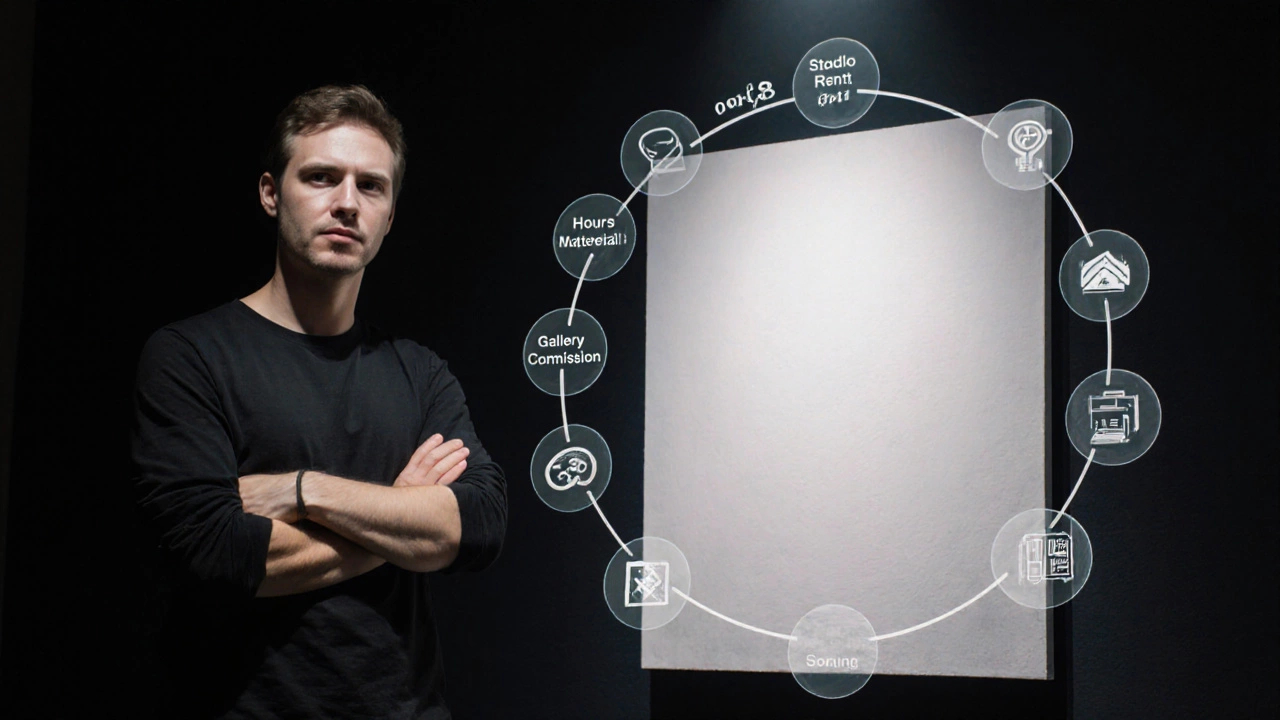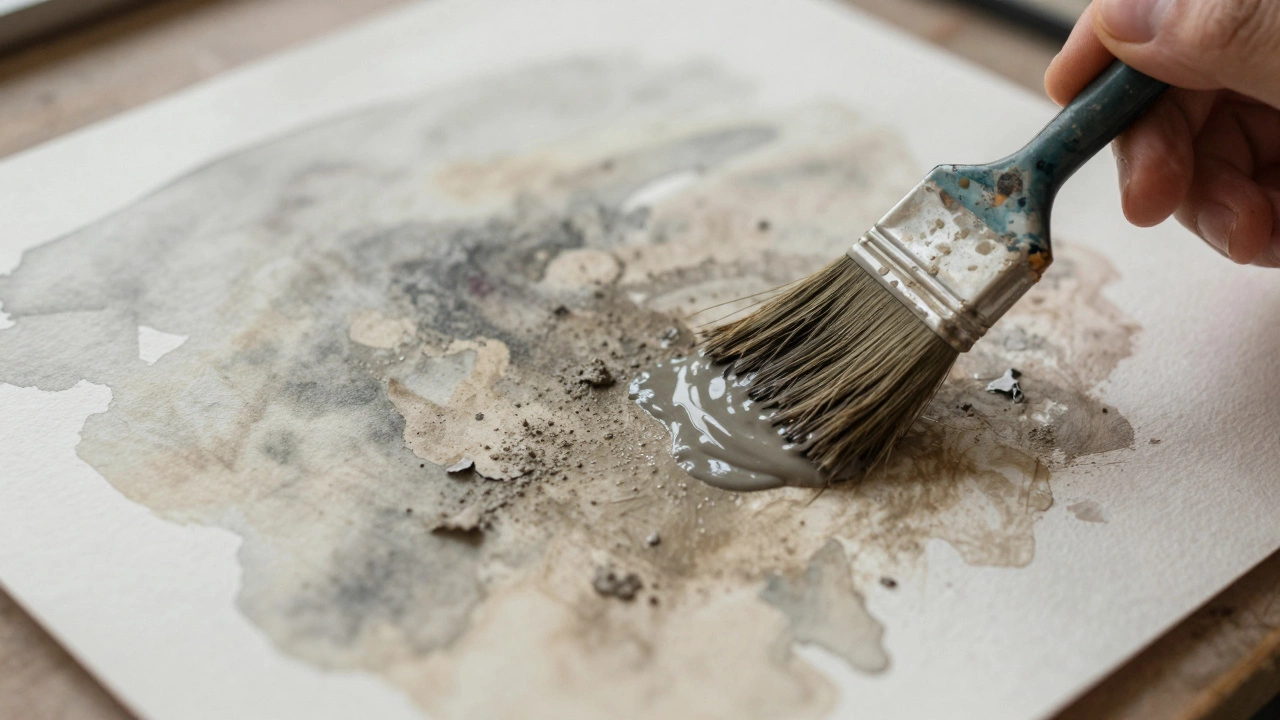Art Pricing Calculator
Calculate Your Minimum Price
Enter your costs to determine your pricing floor
Size-Based Pricing
Adjust based on your work's dimensions
Recommended Pricing
Tiered Pricing Recommendations
Pricing Insights
Key recommendation: Your price should reflect both your costs and market expectations. Avoid discounting during exhibitions—instead, add value through included items like certificates or prints.
Pro tip: Track your sales history to identify which price points convert best. This turns pricing from guesswork into strategy.
Putting your art on display is exciting-but if you price it wrong, you might lose money, alienate buyers, or make your work look cheap. Pricing art isn’t about guessing or copying what others charge. It’s about balancing your costs, your experience, your market, and the value people actually see in your work. Many artists struggle with this. Some underprice out of fear. Others overprice and sit with unsold pieces for years. Neither works. Here’s how to get it right.
Start with your costs
Before you think about what collectors will pay, know what you’ve spent. This isn’t just about paint and canvas. It’s time, materials, studio rent, framing, shipping, and even the cost of your mistakes. If you spent 40 hours on a painting and you want to earn $25 an hour, that’s $1,000 in labor alone. Add $150 for materials, $50 for framing, and $30 for gallery commission prep. That’s $1,230. That’s your floor. Anything below that means you’re working for free-or worse, losing money.Don’t ignore the hidden costs. Did you drive to the gallery? Pay for photo editing? Buy new brushes because you ran out? Track those. Use a simple spreadsheet. You don’t need fancy software. Just write it down. Artists who track costs consistently make smarter pricing decisions and avoid burnout.
Size matters-but not the way you think
A common rule of thumb is to charge by square inch or square foot. For example, $6 per square inch. A 20x30 inch painting is 600 square inches. At $6, that’s $3,600. Sounds high? Maybe. But this method works because it’s consistent. It removes emotion from pricing. It tells buyers you’re not making this up as you go.But here’s the catch: this method only works if your work is comparable in quality and style to others in your niche. If you’re painting hyperrealistic portraits and someone else is doing abstract splatters, don’t use the same rate. Your technique, detail level, and time investment should justify your price. A small, highly detailed watercolor might be worth more than a large, loose oil painting. Don’t let size fool you. Value comes from effort, skill, and uniqueness-not just dimensions.
Know your market
Where are you showing? Who’s buying? A gallery in downtown Chicago expects different prices than a pop-up in a small town in Iowa. Check what similar artists are charging in your region. Look at online galleries, local art fairs, and museum gift shops. Don’t copy them-but use them as anchors.For example, if emerging artists in your city are selling 16x20 inch paintings for $800-$1,200, and your work is more refined, with stronger composition and unique color use, you can price yours at $1,400. But if your technique is still developing, $900 might be more realistic. Buyers compare. If your price feels out of sync with what they’ve seen, they’ll walk away-even if your art is better.
Online platforms like Saatchi Art, Artsy, or even Instagram can give you real-time pricing data. Look at artists with similar experience levels. How many sales do they have? What’s their average price? Use that as a benchmark, not a rule.
Track your sales history
If you’ve sold work before, use that data. Did a piece sell quickly at $700? Did another sit for six months at $1,500? That’s feedback. Don’t ignore it. If your art isn’t moving at a certain price point, it’s not because buyers don’t like it. It’s because the price doesn’t match their perception of value.Keep a simple log: date, title, size, medium, price, whether it sold, and how long it took. After 5-10 sales, patterns emerge. You’ll start to see which pieces sell fast, which need a price drop, and which should be priced higher next time. This turns pricing from guesswork into strategy.

Use tiered pricing
Not every piece in your exhibition needs the same price. Create tiers. This helps buyers feel like they have options-and it subtly guides them toward your higher-value work.- Entry-level: Small pieces, quick studies, or works on paper. Price between $150-$500. These attract new buyers and build your collector base.
- Mid-tier: Larger, more developed pieces. $600-$2,500. This is where most sales happen. Focus your energy here.
- Signature pieces: Your best work-unique, complex, or conceptually strong. $3,000+. These are your statement pieces. They don’t need to sell fast. They establish your reputation.
Having a range makes your exhibition feel dynamic. It also helps galleries sell. They can recommend a $300 piece to a first-time buyer and a $4,000 piece to a serious collector. You’re not limiting your audience-you’re expanding it.
Consider your career stage
A first-time exhibitor shouldn’t price like a gallery-represented artist with five solo shows and articles in Artforum. Your pricing should reflect your experience, not your ambition.Here’s a rough guide:
- Emerging (0-2 shows): $200-$1,500
- Mid-career (3-7 shows, some press): $1,500-$8,000
- Established (8+ shows, museum collections, major galleries): $8,000+
These aren’t rules. They’re starting points. If you’re a self-taught artist with 10 years of daily practice and your work is in private collections, you can price higher than someone with a BFA and one group show. Experience matters more than credentials.
Don’t discount during the show
Once you’ve set your prices, stick to them. If you start offering discounts during the exhibition, you signal that your original price was too high. Buyers will wait. They’ll assume you’ll drop the price later. That kills momentum.If you need to move work, don’t discount. Instead, offer something extra: a free small print with purchase, a signed certificate of authenticity, or a personal note from you. These add perceived value without devaluing the art.
Also, never say, “I’ll take less if you pay cash.” That makes your art feel like a garage sale item. Professional pricing means consistent pricing. Period.

Work with your gallery
If you’re showing in a gallery, they’ll likely have input on pricing. Don’t ignore them. They know their clients. They’ve seen what sells. But don’t let them pressure you into pricing too low. A gallery that pushes you to underprice is not your partner-they’re a middleman trying to move inventory fast.Ask them: “What’s the average sale price for artists at your level?” “Which pieces sold fastest last month?” “What do collectors say when they hesitate?” Use their insights to refine your numbers, not replace them.
And always get pricing in writing. If the gallery changes your price without your approval, you have a problem.
Price with confidence
The biggest mistake artists make isn’t overpricing. It’s apologizing for their price. Saying things like, “It’s not that expensive,” or “I’m still learning,” undermines your work. Buyers don’t want to feel like they’re doing you a favor. They want to feel like they’re investing in something valuable.When someone asks why your piece is $2,200, don’t say, “I spent a lot of time.” Say, “This piece took 60 hours over three months. I used archival pigments and hand-built the frame. It’s one of five in this series. Collectors who own it often come back for more.” That’s not bragging. That’s transparency.
Confidence in pricing isn’t arrogance. It’s professionalism. People pay more for art when they believe the artist believes in its worth.
What to do if nothing sells
If your exhibition ends and most pieces are still unsold, don’t panic. It’s not always about the price. It could be the venue, the lighting, the title, or even the time of year. But if you’ve priced correctly and still no sales, ask yourself:- Is my work too similar to others in the show?
- Is my audience the right one?
- Did I communicate the story behind the art?
- Did I follow up with interested visitors?
Use the feedback. Talk to people who stopped but didn’t buy. Ask, “What stopped you?” Often, the answer isn’t price-it’s confusion, lack of connection, or not knowing who you are as an artist.
Then, adjust. Maybe your next show needs a stronger narrative. Maybe you need to post more about your process online. Maybe you need to target a different collector group. Pricing is just one piece of the puzzle.
Remember: pricing art is not a one-time decision. It’s a practice. The more shows you do, the better you’ll get. You’ll learn what sells, what doesn’t, and why. Over time, you’ll stop guessing. You’ll know.





